Issue #40, Volume #2


History Shows That Wealth Is Created Through Free Trade, Not Tariffs
This is Porter’s Daily Journal, a free e-letter from Porter & Co. that provides unfiltered insights on markets, the economy, and life to help readers become better investors. It includes weekday editions and two weekend editions… and is free to all subscribers.
| Trump’s tariffs will destroy the global economy… Comparative advantage is what really makes the world go round… They will never cut government spending… Fake news about a tariff pause creates volatility… |
President Donald Trump’s tariffs, if left in place, will destroy the global economy.
And this wouldn’t be the first time…
It’s painful to watch.
The Democrats (dumb) did their best to destroy our nation over much of the last 20 years. Surely, dear God, the Republicans (dumber) can’t be even worse!
What Trump is doing with tariffs, designed not to match other nations’ tariffs, but with punitive tariffs designed to eliminate trade deficits with every individual nation, will destroy the global economy.
The S&P 500 Index is down 10% since Trump announced the tariffs last Wednesday, while the Nasdaq, the price of oil, and the price of gold have also fallen since then.
Whether this is a bluff or madness is impossible to determine.
One thing is certain: free trade is vitally important to economic growth and to the creation of wealth.
I wanted to take a moment to show you how I know that free trade lies at the root of the modern world and all its wealth.
And I want to show you what happened the last time a Republican administration told Americans that our trading partners would pay for our bloated government spending.
Wealth Is Created Through Trade: Ricardo’s Comparative Advantage
Economists have known, with certainty, since the late 1700s (see Adam Smith’s The Wealth Of Nations) that the accumulation of trade surpluses does not lead to prosperity. Increases to labor productivity are far more important.
Still, it wasn’t until in 1817 that the incredible benefits of free trade were clearly understood. That year a brilliant market economist, David Ricardo, published On The Principles Of Political Economy And Taxation. This book is the foundation of all modern economics. And the centerpiece of that book is Ricardo’s concept of comparative advantage.
Put simply: different people, in different countries, in different climates, with different cultures and habits all have different kinds of comparative advantages. These advantages can be profound when they have existed for a long time. And they can produce enormous amounts of wealth when they serve the entire global market.
Take Hollywood’s movie industry. That “supply chain” of movie studios, technical know-how, talented actors, script writers, producers, etc., is the world’s leading entertainment content creator. But it is vastly more valuable when it serves the entire world’s market than if it merely made movies and TV shows for its audience in the United States.
And, most importantly, Ricardo proved, with extensive data, that even if a country wasn’t the best at producing anything, it could still benefit from trade by focusing on what it did relatively well, while importing goods others produced more efficiently.
This showed that free trade could lift all nations’ wealth, not just the most productive ones.
Alas, no matter what the Orange Man says, tariffs are not beautiful. They are taxes!
Even worse, they impede the most vitally important economic exchanges, where comparative advantages create tremendous wealth. “Dumping” goods and services at lower prices in our market makes us richer, not poorer.
These ideas have been challenged, again and again, by powerful political forces seeking to control markets, to extract patronage, and to protect favored industries. The claims are always the same – defending national security interests, defending domestic jobs, etc. – but they are simply lies.
The most famous and most widely cited example of how politics, government debt, and the upper-class lead to ruinous barriers to trade were Britain’s infamous Corn Laws.
See if this sounds familiar:
The Napoleonic Wars (1799-1815) against France were extraordinarily expensive. By 1815, Britain’s national debt had ballooned to over £834 million – roughly 200% of its GDP. Repaying this debt and servicing its interest (which consumed nearly half of government revenue in the postwar years!) became a top priority. During the wars, Britain relied heavily on direct taxes like the income tax (introduced in 1799 by William Pitt the Younger).
However, the income tax was very unpopular, especially among the wealthy landowners.
After Waterloo in 1815, with peace restored, public and political pressure mounted to repeal income taxes. After the war (and surely with promises being made about how their trading partners would pay these “beautiful” tariffs), Parliament abolished the income tax and replaced it with a series of tariffs. Much like Trump has adjusted rates to inhibit any trade deficits by making trade with certain countries completely unaffordable (like Vietnam’s 90% rate), the Corn Laws imposed sliding-scale duties on imported grain. And these laws banned grain imports altogether – unless domestic shortages emerged and prices were extremely high.
Much as today’s politicians claim that America’s national security depends on making Nike’s and iPhones in America, in the 1800s, Britain’s elite insisted that its national security was threatened by importing grains.
History rhymes. America’s national debt approaches 150% of GDP. We’ve wasted enormous amounts of capital fighting the Cold War and on the occupations of Iraq and Afghanistan. Combined, these military adventures cost something around $30 trillion.
And with income taxes and estate taxes set at close to 50%, the wealthiest and most powerful people in our country are exhausted by income taxes. Likewise, poor people will always believe that free trade cheats them. There’s always a ready audience of people willing to believe in the lie of protectionism.
But as any reputable economist would tell you, the Corn Laws had the impact of creating high food prices and decreasing agricultural labor productivity, which led to poverty and then starvation. Likewise, making our own iPhones and sewing our own Nikes won’t make us richer. These tariffs, if they remain in place, will decimate our standard of living.
And that’s exactly what happened in Britain.
Finally faced with overwhelming evidence that the Corn Laws hadn’t produced any wealth (and had allowed Britain’s entire agricultural sector to languish) Prime Minister Robert Peel, a Conservative, defied his own party to push for repeal.
In 1846, the Corn Laws were abolished.
The economic impact was miraculous.
Cheap food lowered labor costs for manufacturers, boosting competitiveness. Industries like textiles expanded, cementing Britain’s role as the “workshop of the world.” Exports soared, with trade volume doubling between 1840 and 1870.
Free trade became Britain’s economic hallmark. By reducing tariffs unilaterally, Britain encouraged other nations to lower barriers, fostering a golden age of Victorian prosperity. In 1846, per capita GDP in Great Britain was roughly $4,000 in today’s dollars. By the eve of World War I, per capita GDP had doubled, while Britain’s population had exploded to 45 million people. From not being able to feed its own people in 1846, by 1900, in just over 50 years, London had become the largest and richest city in the world.
The problem with the American economy is not free trade.
The problem with the American economy has been, and will continue to be, the ruinous size of our government (around 40% nominally or around 60% of GDP if you include highly regulated health care).
Virtually all of this money is wasted. Try riding Amtrak. Try getting customer service at the Post Office. Or the IRS. Try using a Veterans Administration hospital. The government destroys everything it touches. Everything. So why does government spending always grow and never decline? Outside of 2010 (when spending fell slightly because of the huge bank bailouts of 2009) and 1969 (when spending fell slightly because of massive increases to military spending in 1968), government spending has not declined, ever, since 1948.
Why do people continue to vote for more government? Because most people don’t have to pay income taxes!
As long as 50% of our population does not pay any meaningful amount of tax, Americans will continue to vote for more government – even though government spending is horrifically wasteful. And don’t forget almost 20% of Americans work for the government (at some level). These people, overwhelmingly, vote for more government spending.
We’re a democracy that’s figured out how to vote our neighbors’ wallets.
That’s a democracy that’s going to collapse. Pretending to shift these burdens to our trading partners won’t work. Instead, we will lose access to the world’s markets. We will lose tremendous amounts of wealth that’s currently generated today through comparative advantage. And government spending will have to increase as millions of people will lose their jobs.
And here’s the part that drives me nuts. We’ve made all of these same mistakes before! Following World War I, all of this same nonsense was promised by wealthy (and corrupt) Republican politicians.
In 1930, the Smoot-Hawley Act extended and increased earlier tariffs (Fordney-McCumber Tariff of 1922) that were enacted “to save American farmers.”
Farmers, whose incomes were cut in half with the resumption of European farming after World War I, were demanding the government do something to increase domestic farm prices – aka, enact Corn Laws. But did this help the farmers? Of course not. The Fordney-McCumber Tariffs led to higher costs on many of the things farmers needed, while limiting U.S. exports because of reciprocal tariffs, creating an even worse glut of agricultural products. For farmers, the Great Depression started in 1922.
But, tariffs – “beautiful” tariffs – sound good! So Herbert Hoover and the Republicans decided to increase these tariffs and expand them to cover virtually all imports (Smoot-Hawley).
The average tariff was increased to 45%. Later, in 1931, those rates increased to 50% and finally to 60% in 1932.
It isn’t a coincidence that these tariffs coincided with the worst economic calamity in American history. Smoot-Hawley became law on June 17, 1930, with the Dow Jones Industrial Average at 228.5. By the time the tariff rates reached their peak (1932) the Dow had fallen to 41.22, a decline of over 80%.
Someone needs to explain to the Orange Man that destroying global markets with an unaffordable, sudden tax didn’t do anything to help Main Street. Unemployment, which was around 4% prior to Smoot-Hawley, reached almost 30% by 1932.
I’m sure you’ve heard that tariffs will allow the president to shut down the IRS because these “wonderful, beautiful tariffs” will provide so much revenue that we won’t need internal revenue anymore. Likewise, you’ve been promised that the Department Of Government Efficiency (“DOGE”) is going to cut $1 trillion in wasteful spending. The government claims the combination of tariffs and DOGE will unlock “the greatest period of American prosperity of all time.”
Nonsense.
Just like last time, killing global trade will destroy a huge percentage of our economy and lead to massive unemployment. And that, in turn, will drive big increases to government spending and even larger budget deficits.
Look what happened to government spending in the 1930s, for the exact same reasons.
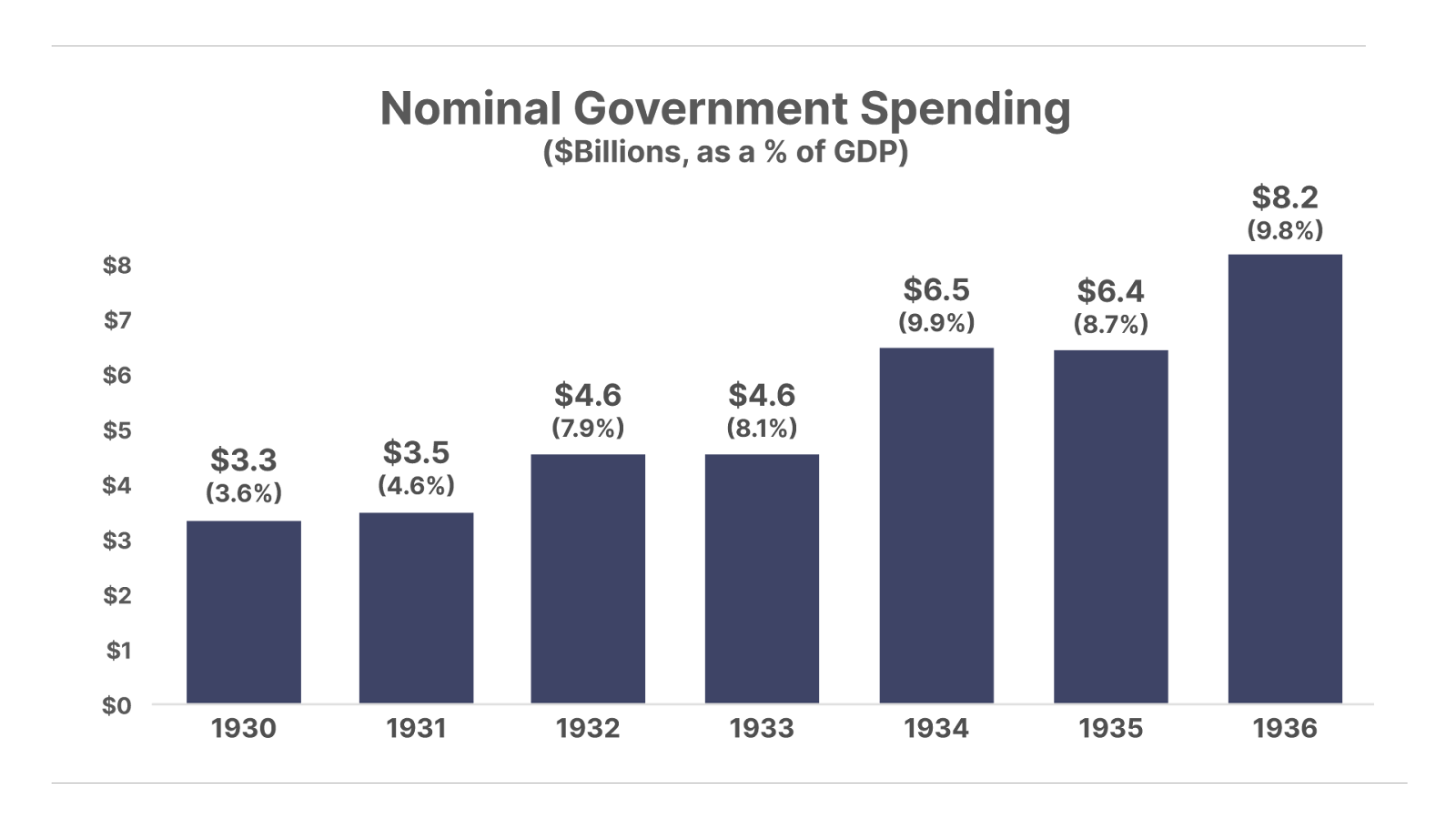
When Smoot-Hawley destroyed the global economy, about 30% of Americans lost their jobs. The wealthiest people in the country saw the value of their stocks decline by more than 80%. All of the gold in the country was confiscated. And the dollar was devalued by roughly 30%.
Did “beautiful tariffs” help anyone? They helped the government by destroying the private sector. Nominal government spending more than doubled. And as a percentage of GDP, government spending tripled.
Repeat after me: they will never, ever cut spending.
The world doesn’t need more taxes or more tariffs.
It needs less government.
This Is NOT A Drill
For a limited time you can learn how to get pre-IPO exposure as Elon Musk commences his next trillion-dollar venture. And you can do it with any brokerage account.
Get the details completely free. But this video goes “dark” any moment now.
For the best shot at big gains, you have to get in ASAP – before it goes public.
Three Things To Know Before We Go…
1. False report unleashes volatility in stocks. After falling by as much as 6% in the overnight futures trading, U.S. stock indexes briefly rose into positive territory this morning on news that the White House was considering a 90-day pause on the sweeping tariffs announced by President Trump last week. The 8% swing marked the biggest intraday move in the S&P 500 since March 2020. A few hours later, the White House denied the reports, sending stocks back down. This extreme volatility is classic bear market behavior, and we expect more of the same. Our advice: Use the volatility to your advantage. Tune out the day-to-day noise and focus instead on a long-term plan of accumulating stocks you want to own forever when they trade at attractive prices.
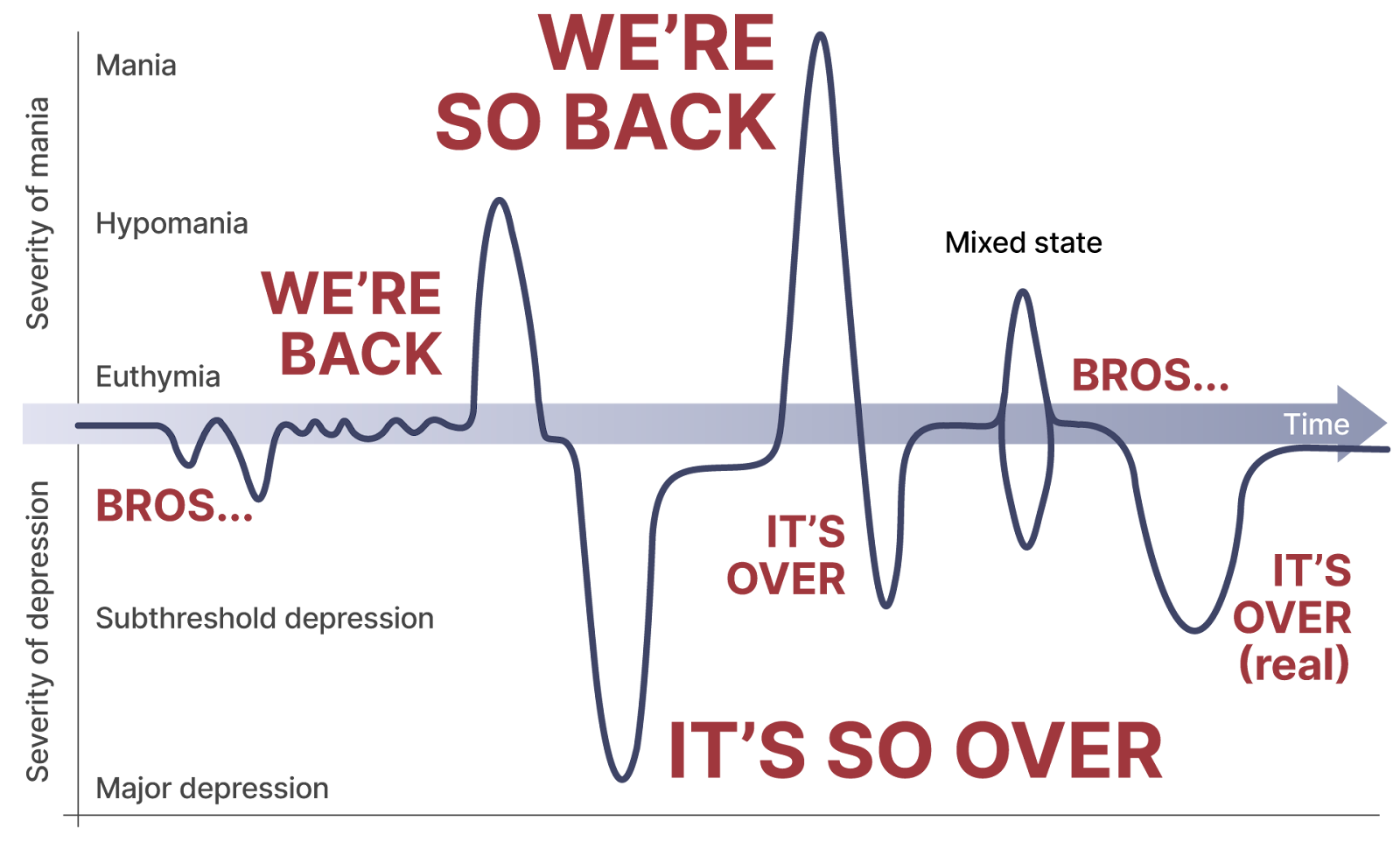
2. Early signs of trouble in the Treasury market? As noted on Friday, President Trump and Treasury Secretary Scott Bessent have said that bringing down long-term rates is a key policy objective. And rates had been falling, with the 10-year U.S Treasury yield dipping below 4% for the first time in six months last week. However, with stocks trading lower again today, rates have been moving higher again. As we go to press, the 10-year U.S. Treasury yield is trading at 4.15%… meaning rates are now down only around 3 basis points since tariffs were announced last Wednesday. One day does not make a trend, but a continued rise in rates despite weakness in stocks could potentially derail the President’s economic agenda.
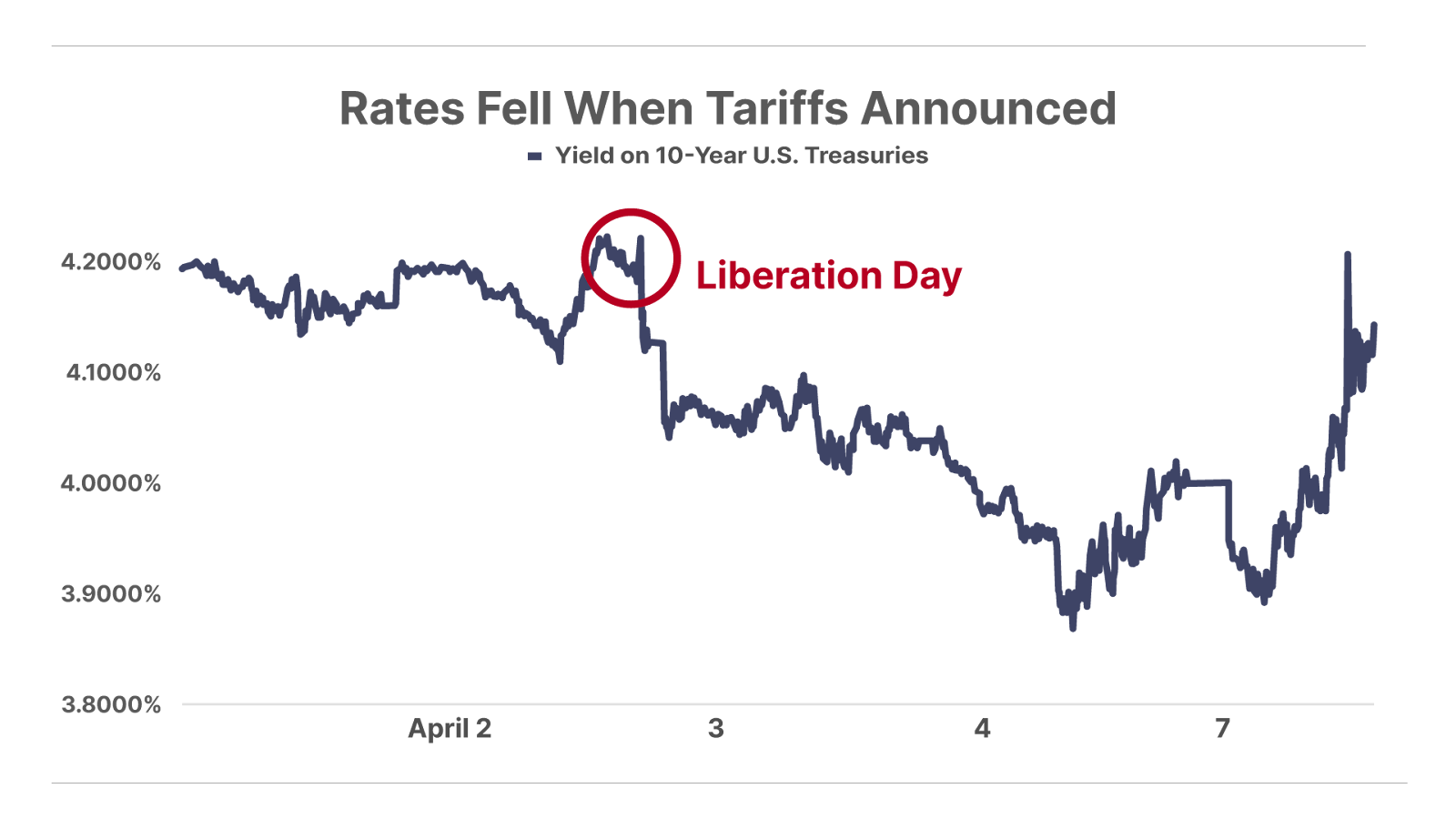
3. How long till the Fed gives in? Crude-oil prices have fallen 15% year-to-date, and the Truflation U.S. Inflation Index, which uses real-time consumer spending data, has recorded its lowest level since May 2020, while the March year-over-year CPI reading is expected to fall to 2.6% from 2.8%. Consumer sentiment has cratered, and long-term inflation expectations are starting to decline from short-term expectations. Now, markets are currently pricing in an 85% chance of a 25 basis point rate cut at the Fed’s June meeting.
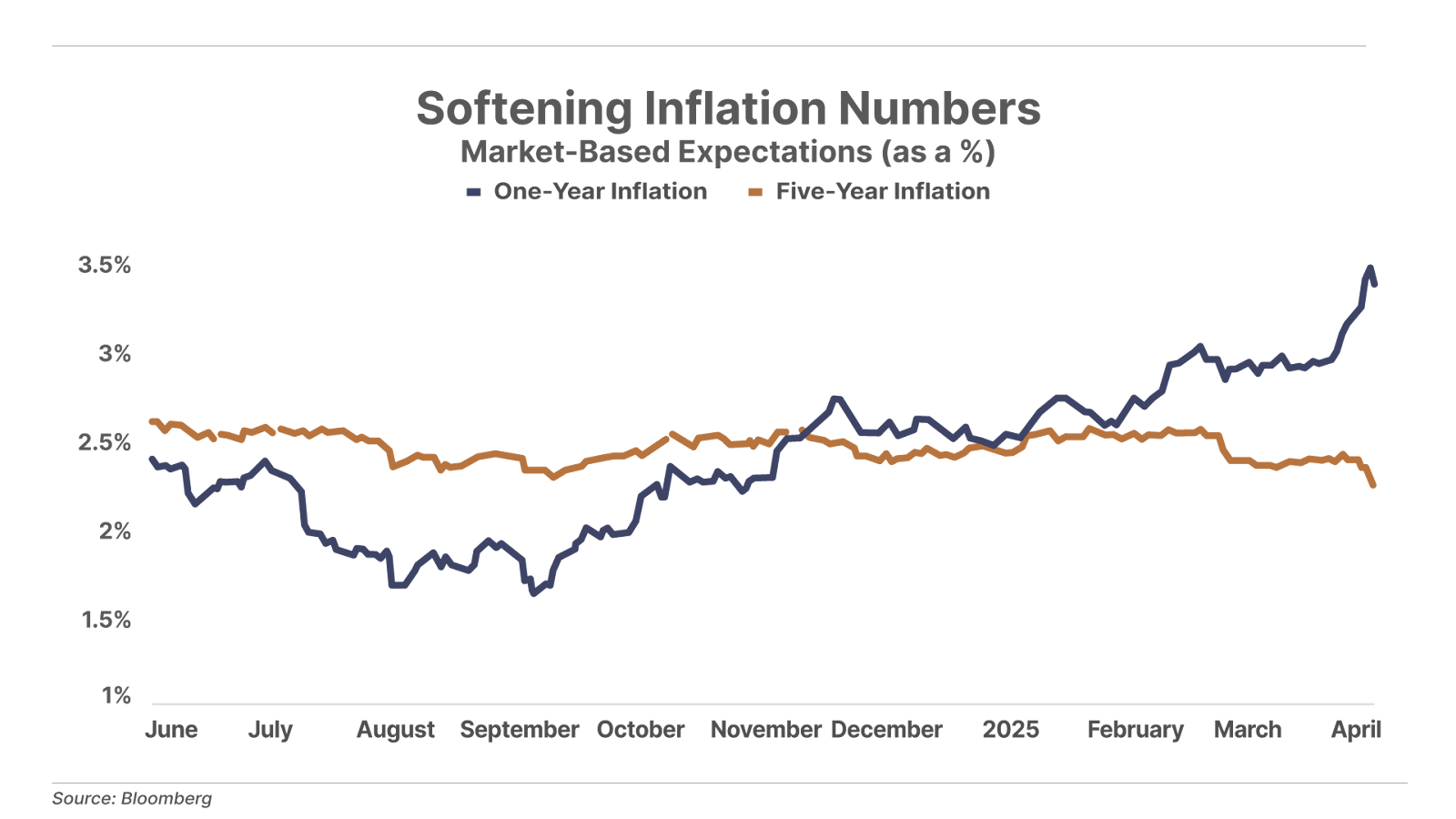
And one more thing… Trump threatens additional tariffs on China
In response to President Trump’s recent tariffs, China said over the weekend that it would impose a new 34% retaliatory tariff on U.S. imports. This morning, via his Truth Social account, President Trump announced that if China does not remove those tariffs by tomorrow, April 8, the U.S. will impose an additional 50% tariff on China beginning April 9. This would effectively raise the total tariff rate on China to a massive 104%. Be prepared for more volatility.
As always, let me know what you think: [email protected]
Good investing,
Porter Stansberry
Stevenson, MD
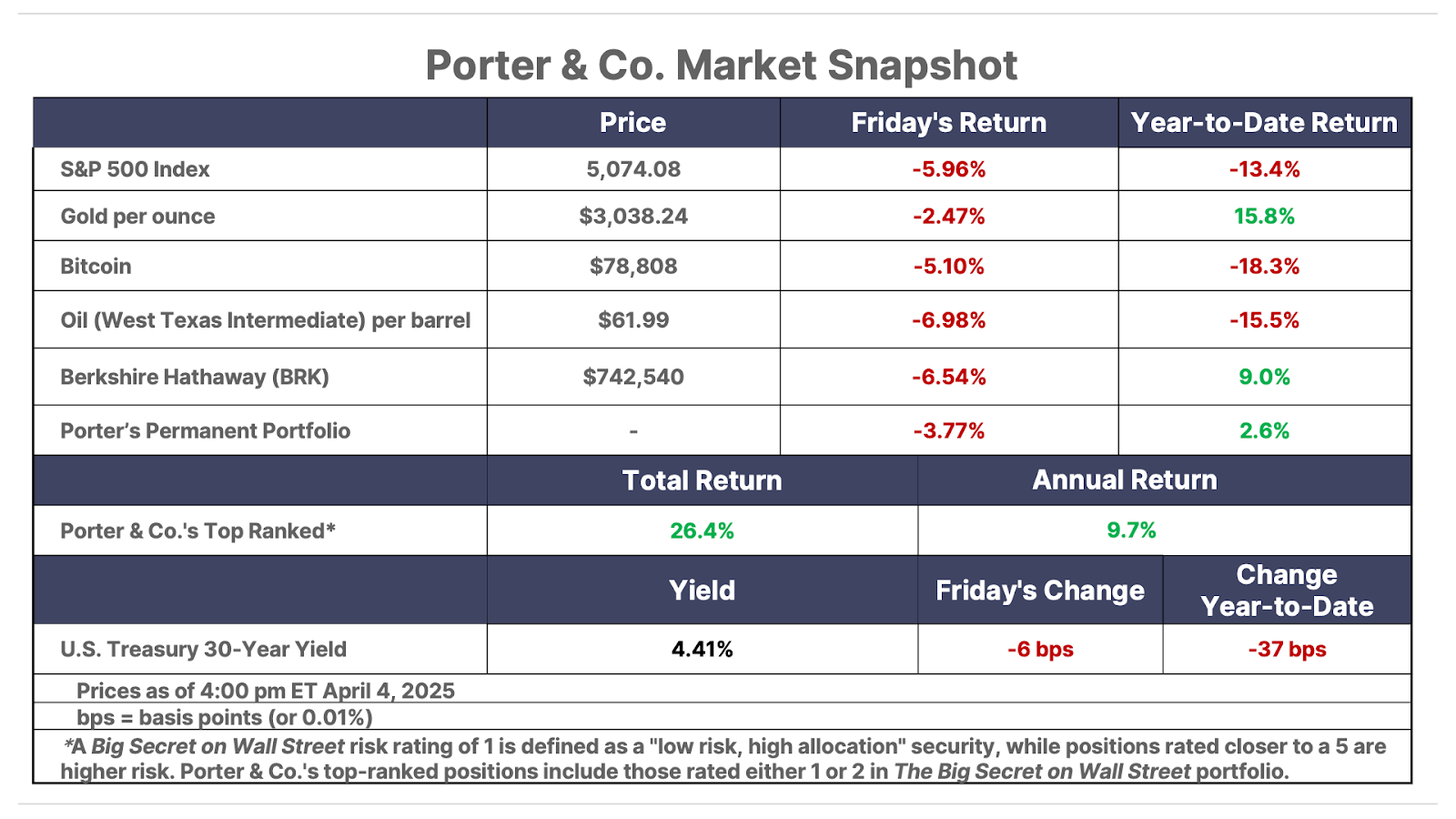
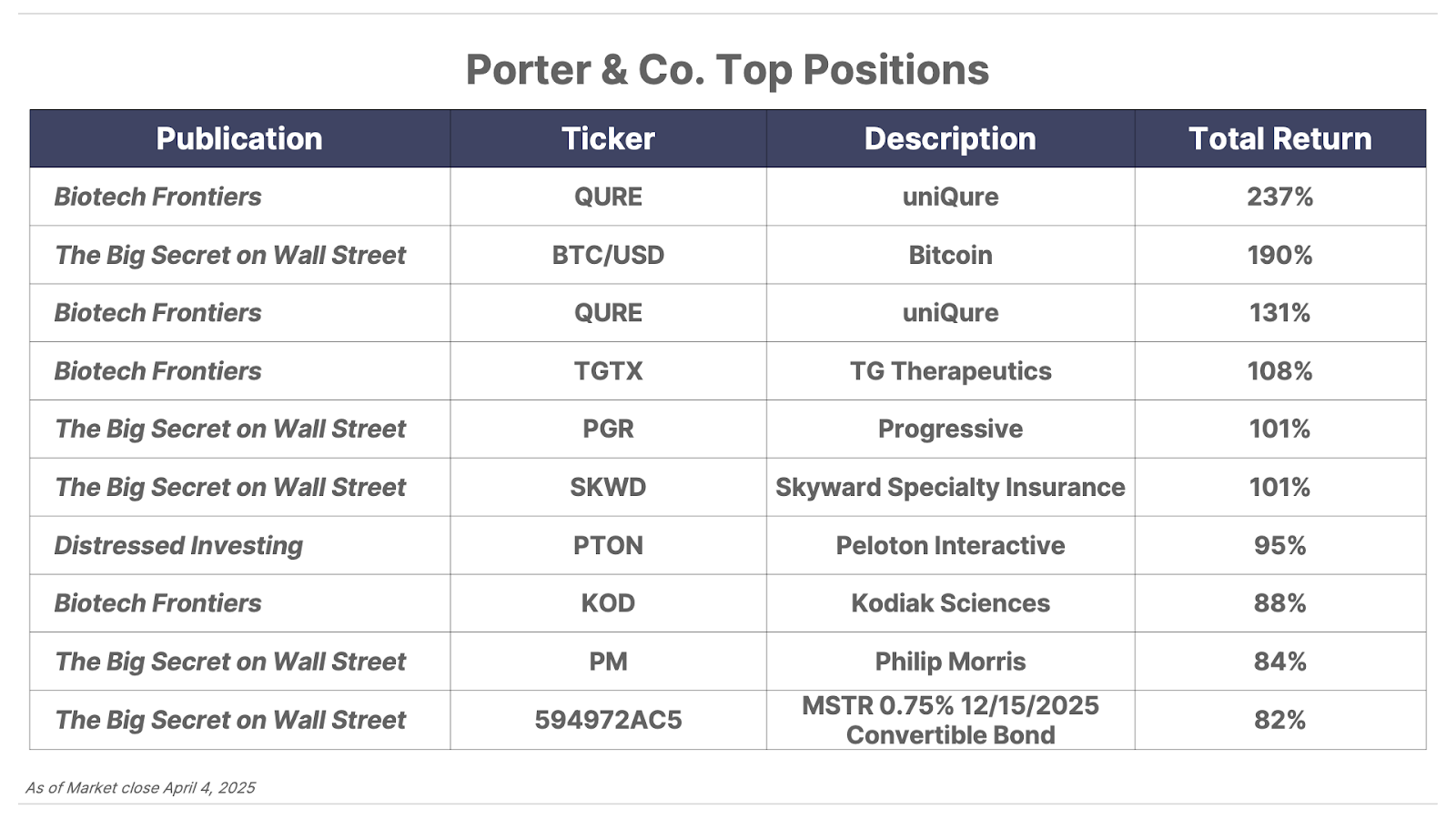
Please note: The investments in our “Porter & Co. Top Positions” should not be considered current recommendations. These positions are the best performers across our publications – and the securities listed may (or may not) be above the current buy-up-to price. To learn more, visit the current portfolio page of the relevant service, here. To gain access or to learn more about our current portfolios, call Lance James, our Director of Customer Care, at 888-610-8895 or internationally at +1 443-815-4447.